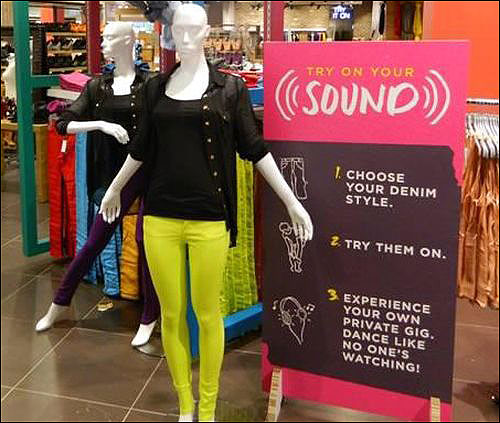Customers trying on clothing at Australian fashion retailer Cotton On can listen to music specifically chosen to suit the style of a particular garment, following the introduction of radio frequency identification technology at one of its Queensland stores.
In fitting rooms within its store located in the Brisbane suburb of Carindale, the retailer has launched its Try On Your Sound service, in which selected denim jeans carrying an RFID tag will trigger a playlist of music individually chosen to match that clothing.
|
|
Mark Coombes, Cotton On’s group marketing manager, says the technology was designed to create a “mini gig” experience in the fitting rooms for its target market of teenagers to young adults—a generation that he says defines itself both by music and fashion, as a means of self-expression.
“So we thought, ‘Why not combine the two in our stores and breathe life into the fitting-room experience?'” Coombes says. “In our search for tracks that reflected our garment styles, we focused on hot-off-the-press, emerging Australian artists and cutting-edge international acts not yet spun on commercial radio. It gives shoppers a unique in-store experience that will be different for every individual, according to taste.”
Coombes says technology is a large part of the lives of its customers, who already engage with the company via social-media sites, such as Twitter and Facebook. RFID, he adds, is another method in which the firm can now connect with its patrons in a fun way.
“Shoppers are loving it,” Coombes states, “and we hope this becomes another reason for customers to come and shop with us.”
Cotton On contacted Australian RFID solutions provider Unique Micro Design (UMD) to develop and implement the solution over a period of just six weeks, as the Carindale store was being refurbished. This, Coombes says, provided the best opportunity to install the new system into the fitting rooms.
Geoffrey Ramadan, UMD’s managing director, says the design concept, procurement of parts, software development and rollout were all accomplished in quick succession.
“We had planned to do a formal pilot in one store, but did not get the chance,” Ramadan explains. “However, we were able to assemble a system at our facilities for testing and software development, and used a corner of our office to provide a basic simulation of a change room.”
A range of men’s and women’s denim jeans were tagged with Alien Technology ALN-9634 “2×2” wet (adhesive) inlays, which comply with the EPC Gen 2 and ISO 18000-6C standards, and operate on a frequency between 840 MHz and 960 MHz.
The tags, designed specifically for apparel applications, were chosen without first being tested, due to the short time involved in developing the system, but Ramadan says he was pleased with the tags’ performance during the rollout phase.
UMD designed an RFID interrogator that incorporates a SkyeTek RFID reader module, and configured the module to comply with Australian regulatory frequency requirements, 920 to 926 MHz.
“The RFID tags are attached at store level, with staff simply sticking the RFID tag to existing swing tags [hangtags] on the clothes,” says Ramadan. “We custom-developed a tag programmer, which consisted of a small controller, SkyeTek reader and Honeywell 1900 USB bar-code scanner. The operator simply scans the item bar code on the apparel swing tag and places the RFID tag on the ‘target’ printed on the box. The device then converts this to a GS1-format EPC number, and programs and verifies the tag.”
With each changing room, the reader was mounted behind an access door, with just a small Laird Technologies RFID antenna and a passive infrared sensor to activate the system when someone enters that room. In total, readers were installed within 12 changing rooms.
The information is collected and monitored via UMD’s cloud-based system, known as UMD-REAP Retail Edgeware Application Platform). In the future, Cotton On reports, the middleware could integrate with the retailer’s RFID tag programmer and point-of-sale system for managing inventory, including the use of handheld interrogators for stocktaking.
In addition, Cotton On plans to roll out the $50,000 solution to other stores as they are refurbished—up to 40 sites nationwide—and to tag new apparel lines as they are introduced.
Coombes says shoppers can share their experience in the RFID-enabled fitting rooms with friends and Cotton On through Twitter by adding #tryonyoursound to their tweets. He says the customer feedback received in this way will help shape Cotton On’s future application of RFID technology and further developments of the fitting rooms.
“All going well, we plan to roll this out in every major city in the world where there is a flagship Cotton On store,” Coombes reports.


